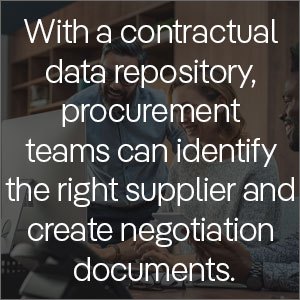There was a time when the procurement role was not perceived as distinctive in its own right. This, even though procurement professionals must handle vendors, suppliers, or subcontractors – staying on top of master services and licensing agreements, service level agreements, regulatory compliance, technical and pricing addendums, purchasing orders, and statements of work. In fact, the entire procurement process was once referred to as simply “purchasing, whether it concerned direct purchases (components of the final product) or indirect purchases (goods and services for internal use).
In recent years, however, procurement professionals have certainly come into their own.
Procurement managers have come to represent companies by searching for and negotiating the best deals for the business. Procurement departments have started to contribute to strategic areas of companies, transforming themselves into crucial elements of organizational performance. Now, procurement is considered strategic sourcing and plays a central role in all major corporations – with companies tracking ‘spend under management’ as a central, strategic KPI. Essentially, every dollar saved is retained earnings.
Strategic Sourcing Explained
Strategic sourcing is “a standardized and systematic approach to supply chain management,” according to Gartner. “It formalizes the way information is gathered and used. … Strategic sourcing enables organizations to leverage their consolidated purchasing power to find the best possible value in the marketplace.”
These days, most companies also track their vendors for other strategic imperatives, such as the business risk for purchased products and services, as well as through vendors’ own supply chains. Increasingly, businesses track an ever-broadening range of metrics; environmental ‘green’ initiatives; diversity and inclusion compliance; health and safety; trade policies and restrictions; fraud and malfeasance; reputational risk – and adherence to literally thousands of global regulatory rules and guidelines.
And both positively and negatively, “the [COVID-19] pandemic prominently placed the supply chain in a spotlight for all to see,” Gartner points out. This only underlines the profession’s “importance to the masses.” In its 2020 “Future of Supply Chain” survey and follow-up report, Gartner also acknowledged that the supply chain profession has led the “digitalization of ecosystems, delivering the customer experience, managing trade uncertainty, and applying circular economy concepts.”
Central to the overall procurement process is supplier and buyer contracts. Most organizations have the ability to store and maintain contracts in a simple repository. But few meet the standard of best practices for managing critical work processes. In fact, companies struggle to manage or even track aggregate risk, obligations, insurance and remediation, renewal cycles, litigation, and GRC, as well as the work efforts necessary to sustain the operation.
Strategic Sourcing with CLM Solutions
More and more organizations are centralizing and automating procurement processes by deploying cloud- and AI-based contract lifecycle management (CLM) solutions. Such systems are necessary to make procurement a well-managed process, not to mention improve margins, and minimize risk and costs. With CLM software, a procurement team can be even more strategic in their sourcing and negotiations, and proactively manage all aspects of the procurement and contract management lifecycle. Without it, they face inconsistency across agreements, unnecessary legal risks, unwieldy work processing, potential fraud — and, of course, supply chain continuity issues.
To improve contract management throughout the procurement process, though, teams should strive to adopt best practices around the use of CLM solutions. Here are four of them:
Streamline procurement processes
Today’s procurement — or strategic sourcing — departments can more easily search for contract-related information when it is stored in a digital format in the first place. That not only means creating a single, central repository, but also tagging contracts for important ‘metadata.’ This makes it easy to find content — and analyze and manage it in the aggregate. For instance, Fortune 500 companies easily have 30,000 to 75,000 supplier contracts in force — with many managing 150,000 or more contracts. In some industries, regulators require persistent records’ retention for products that may go back decades.
Fortunately, AI and other business intelligence tools offer insights and inspect content, delivering solid benefits. They determine what is in the inventory of content and the best practice for managing it.
Additionally, most corporations have multiple repositories or simple ‘file-sharing’ capabilities. But now, the standard of excellence is a central, full-function CLM platform. It spans legal operations and procurement to enable a consistent, ‘wholistic,’ and streamlined strategic procurement process.
Stop creating purchase and negotiation orders manually
On top of successful negotiations, strategic procurement is dependent on the qualification of suppliers. To make certain suppliers comply with corporate policies, procurement professionals need to monitor supplier data closely. They can only select the best suppliers after they collect important supplier qualification information. They can then create purchase order templates that include a list of approved suppliers and supplier profile data.
By using CLM software, however, these professionals can access the most up-to-date contract information to create purchase orders. It is powered by artificial intelligence, which helps to check contract compliance and reduce costs. Naturally, using such a tool is certainly better than compiling and comparing supplier proposals manually. The latter can be tedious, error-prone, and time-consuming.
Achieving bottom-line results is made possible through the automation of negotiations and supplier selections. With a comprehensive, contract data repository, procurement professionals can identify the right supplier, and create negotiation documents more simply and effectively. Contract data will include pricing, service-level agreements (SLA), business obligations, and terms and conditions.
Also, more advanced CLM software ensures a company’s approval policies are followed and all vital information is included in every agreement.
Better monitor and manage terms and expenses
The transparency of spending in procurement functions and strategic sourcing leads to cost savings, too.
When procurement professionals use CLM software, they can more easily monitor and track expenses related to contracts with vendors and suppliers. Instead of multiple spreadsheets, which risk manual errors and incomplete data, they can use graphical dashboards and customizable contract management reports, and establish “an official version of the truth.” They can then provide answers immediately and report data related to supplier agreements more accurately.
With a centralized repository for all contracts and related documents also, procurement professionals can better monitor and manage contractual terms, as well as ensure compliance and governance. By leveraging pre-approved clauses and template libraries — ensuring the use of pre-approved language and formats — they can efficiently identify and report where certain clauses and terms are used.
Increase the visibility of supplier performance with strategic sourcing
Finally, automation helps procurement departments flag contract expiration dates, and measure suppliers’ compliance and fidelity to contract terms. This helps them remain aware of deadlines and ensure contractual milestones are attained. This helps them identify and correct issues early on. Ultimately, automation optimizes return on investments by reducing the costs of multi-supplier maintenance and improving relationships with individual suppliers.
By deploying an advanced CLM solution, in particular, procurement departments can increase visibility into contract performance and enforce compliance. With real-time data insights, they can analyze the performance of suppliers, determining which ones are meeting their obligations and which ones are not. They can then manage obligations accordingly, and define the most effective key performance indicators (KPIs).
Enhancing the performance of your procurement team
Generally speaking, then, new legal technology provides procurement teams an opportunity to increase capacity, speed, trust, and market coordination. The removal of human error not only boosts the performance on the buyers’ side, but also enhances the performance on the suppliers’ side. And this improves innovation and collaboration — and strengthens the buyer-supplier relationship altogether.
Clearly, the best practice is using cloud- and AI-based contract management software. Leveraging such legal tech makes the most logical sense for contract, supplier, and financial savings management, as well as the spend analysis and strategic sourcing process. With it, procurement professionals can drive competitive performance in all of these strategic function areas.
ContractPodAi’s CLM solution helps procurement teams and companies execute agreements with new parties, efficiently and effectively. It supports the management of internal and external relationships, and the improvement of procurement process efficiency. In the end, this helps to mitigate risk, adhere to governance requirements, and reduce supplier costs. This, while improving sourcing strategy and productivity overall.
Author:

Edward Chick
Connect with us on Linkedin





